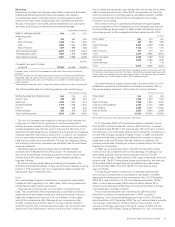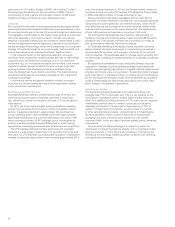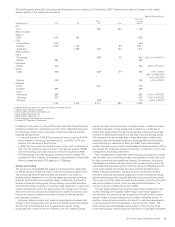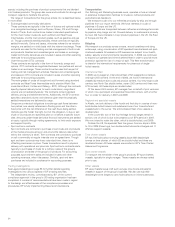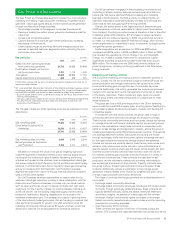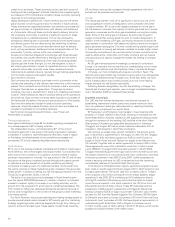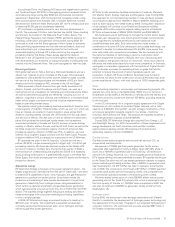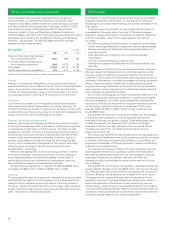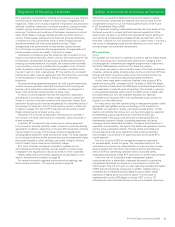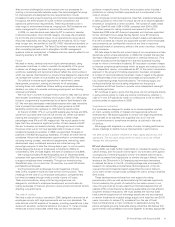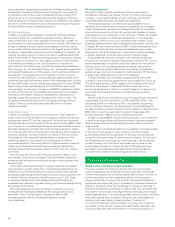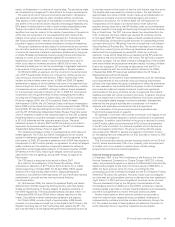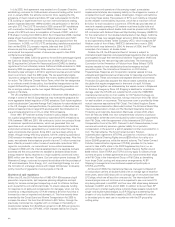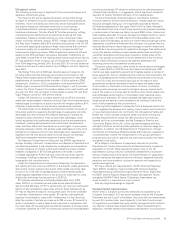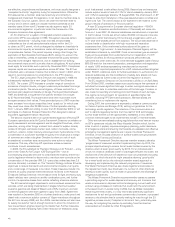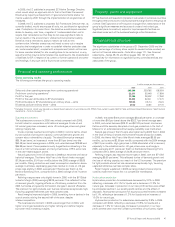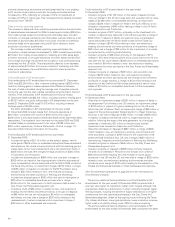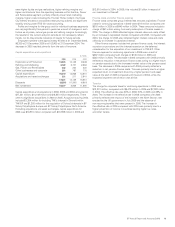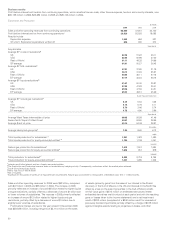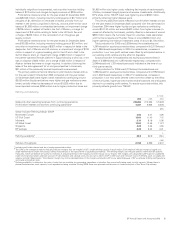BP 2006 Annual Report Download - page 43
Download and view the complete annual report
Please find page 43 of the 2006 BP annual report below. You can navigate through the pages in the report by either clicking on the pages listed below, or by using the keyword search tool below to find specific information within the annual report.after we were challenged by some investors over our processes for
working in environmentally sensitive areas. We acknowledged the scope
for improvement and designed the new requirements to include
processes for early project screening, environmental impact assessments
throughout the entire project life cycle, external consultation and
operational performance requirements. These requirements cover a
wide range of environmental impacts, ranging from GHG emissions and
water management to impacts on communities and wildlife.
In 2006, no new decisions were taken by BP to explore or develop
in World Conservation Union (IUCN) category I-IV areas. We constantly
try to limit the environmental impact of our operations by using natural
resources responsibly and reducing waste and emissions. All our major
sites, except two, are certified to the ISO 14001 international standard on
environmental management. The Texas City refinery intends to recertify
after completing planned work to strengthen its HSE management
systems, while an acetyls plant in Malaysia was only recently added to our
reporting boundary for ISO 14001.
People
We seek to attract, develop and retain highly talented people, using
appropriate incentives, in order to maintain the capability of the group
to deliver our strategy and plans. As a global group, we believe our
workforce, leadership and recruitment should reflect the communities in
which we operate. We therefore run programmes designed to ensure that
we increase the number of local leaders and employees in our operations.
Our policy is to ensure equal opportunity in recruitment, career
development, promotion, training and reward for all employees,
including those with disabilities. Where existing employees become
disabled, our policy is to provide continuing employment and training
wherever practicable.
We now have a number of programmes in place to help raise our senior
level leaders’ awareness of diversity and inclusion (D&I). Our ‘Managing
Inclusion’ programme is recommended for all senior level leaders in the
US. We have also developed a web-based resource that uses interactive
tools to present the business case for D&I, give guidance on D&I
leadership and provide a gateway to other learning opportunities.
At the end of 2006, 17% of our top 622 leaders were female and 20%
came from countries other than the UK and the US. When we started
tracking the composition of our group leadership in 2000, these
percentages were 9% and 14% respectively. We recruit people in the
hope that they will spend a significant portion of their careers with BP.
We aim to develop our leaders internally, although we recruit outside
the group when we do not have specialist skills in-house or when
exceptional people are available. In 2006, we appointed 70 people to
positions in the 622-strong group leadership. Of these, 50 were internal
candidates. We provide development opportunities for our employees,
including training courses, international assignments, mentoring, team
development days, workshops, seminars and online learning. We
encourage everyone to take five training days a year. In our two-yearly
People Assurance Survey of employees, conducted in 2006 and
completed by 73% of those eligible, the level of satisfaction was 66%.
We had approximately 97,000 employees as at 31 December 2006,
compared with approximately 96,200 at 31 December 2005. We continue
to support employee share ownership. Through our award-winning
ShareMatch plan, run in more than 70 countries, we match BP shares
purchased by employees.
Communications with employees include magazines, intranet
sites, DVDs, targeted e-mails and face-to-face communication. Team
meetings are the core of our employee consultation, complemented
by formal processes through works councils in parts of Europe.
These communications, along with training programmes, are
designed to contribute to employee development and motivation by
raising awareness of financial, economic, social and environmental factors
affecting our performance.
The code of conduct
We have a code of conduct, launched in 2005, designed to ensure that all
employees comply with legal requirements and our own standards. The
code defines what BP expects of its people, providing expectations in key
areas such as safety, workplace behaviour and use of IT. It also provides
references to show employees where they can find more detailed
guidance on specific areas. Our strict anti-corruption policy includes a
prohibition on making facilitation payments and is incorporated in the
code of conduct.
Our employee concerns programme, OpenTalk, enables employees
to seek guidance on the code of conduct as well as to report suspected
breaches of compliance or other concerns. The number of cases raised
through OpenTalk was 1,064 in 2006, compared with 634 in 2005.
Another avenue for raising concerns was opened in the US in
September 2006 when BP America’s president and chairman appointed
former US District Court Judge Stanley Sporkin to be BP America’s
ombudsperson. This followed concerns raised in Alaska and elsewhere.
His role is to serve as a neutral and supportive adviser whom employees
and contractors can confidentially contact at any time to report any
suspected breach of compliance, ethics or the code of conduct, including
safety concerns.
We take steps to identify and correct areas of non-compliance and take
disciplinary action where appropriate. In 2006, this included the reported
dismissal of 642 people for non-compliance or unethical behaviour. (This
number excludes some dismissals from the retail business including
those for minor or immaterial incidents.) BP has taken a number of steps
to improve compliance performance within its supply and trading function.
The independent review, commissioned by BP, of the current compliance
approach in the group’s US trading organization has been completed.
A number of recommendations have been made in regard to the design
and effectiveness of the compliance processes and procedures. BP is
fully implementing these recommendations. The existing supply and
trading compliance function is being integrated into the group’s
Compliance and Ethics function to provide more independent oversight
over trading activities.
BP continues to apply a policy that the group will not participate directly
in party political activity or make any political contributions, whether in
cash or in kind. BP specifically made no contributions to UK or other EU
political parties or organizations in 2006.
Suppliers and contractors
Our processes are designed to enable us to choose suppliers carefully
on merit, avoiding conflicts of interest and inappropriate gifts and
entertainment. We expect suppliers to comply with legal requirements
and we seek to do business with suppliers who act in line with
BP’s commitments to compliance and ethics, as outlined in the code
of conduct.
We engage with suppliers in a variety of ways, including performance
review meetings to identify mutual improvements in performance.
We seek to have a positive influence on major issues beyond our own
operations. The two main areas where we seek to do so are climate
change and development.
BP and climate change
During 2006, we made further investments to increase the supply of low-
carbon energy, both for power and transport. Our activities came against
a background of intensifying public concern and debate over the issue.
As well as international negotiations on climate change in Nairobi, world
leaders at the G8 summit in St Petersburg recommitted themselves
to address the issue. In the US, a funding package was announced for
research into renewable and alternative technologies and, in the UK,
a government-commissioned report argued that the cost of failing to
act to avert climate change would outweigh the cost of acting to stabilize
GHG levels.
These developments reinforced our own support for taking
precautionary action as well as demonstrating the business opportunity
that is created by the growth of markets for low-carbon power. In our
view, the goal must be to take urgent but informed measures that will
stabilize GHG concentrations by delivering sustainable and cost-efficient
long-term emission reductions. We must address the fact that fossil
fuels currently supply most of the energy people use and are projected
to remain fundamental to global energy supply for at least the next 20-30
years. Innovation to reduce CO
2
emissions from the use of fossil
fuels will therefore be a major contributor to stabilization during this
period, alongside growing renewable energy industries. We believe that
governments and businesses must work together to develop appropriate
BP Annual Report and Accounts 2006 41


